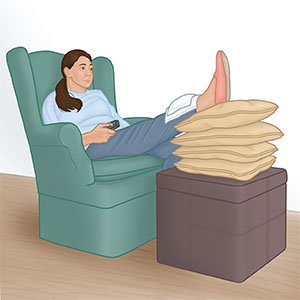Ankle Strain
Medically reviewed by Drugs.com. Last updated on Aug 4, 2025.
AMBULATORY CARE:
An ankle strain
is a twist, pull, or tear of a muscle or tendon in your ankle. An acute strain is a strain that happens suddenly. A chronic strain can happen over several days or weeks. A chronic strain can be caused by moving the muscle and tendon in your ankle the same way over and over.
Common signs and symptoms include the following:
- Pain and swelling in your ankle
- Trouble moving your ankle
- Muscle spasm, cramping, or weakness
- Bruising over your ankle
Seek care immediately if:
- You have severe pain in your ankle when you rest or put pressure on it.
- Your foot or toes are cold or numb.
- Your swelling has increased.
Contact your healthcare provider if:
- Your pain or swelling do not go away, even after treatment.
- You have questions or concerns about your condition or care.
Treatment:
- A support device , such as crutches or a brace, may be needed to decrease your pain as you move around.
- NSAIDs , such as ibuprofen, help decrease swelling, pain, and fever. This medicine is available with or without a doctor's order. NSAIDs can cause stomach bleeding or kidney problems in certain people. If you take blood thinner medicine, always ask if NSAIDs are safe for you. Always read the medicine label and follow directions. Do not give these medicines to children younger than 6 months without direction from a healthcare provider.
- Acetaminophen decreases pain. It is available without a doctor's order. Ask how much to take and how often to take it. Follow directions. Acetaminophen can cause liver damage if not taken correctly.
- Physical therapy may be recommended after your ankle strain has healed. A physical therapist teaches you exercises to help improve movement and strength, and to decrease pain.
- Surgery may be needed if you have a severe strain.
Manage your symptoms:
- Rest your ankle so that it can heal. Return to normal activities as directed.
- Apply ice on your ankle for 15 to 20 minutes every hour or as directed. Use an ice pack, or put crushed ice in a plastic bag. Cover it with a towel. Ice helps prevent tissue damage and decreases swelling and pain.
- Compress your ankle as directed. Ask your healthcare provider how to wrap an elastic bandage around your ankle. An elastic bandage provides support and helps decrease swelling and movement so your ankle can heal. Wear it as long as directed.
- Elevate your ankle above the level of your heart as often as you can. This will help decrease swelling and pain. Prop your ankle on pillows or blankets to keep it elevated comfortably.

Prevent an ankle strain:
- Always wear proper shoes when you play sports. Replace your old running shoes with new ones often if you are a runner. Use special shoe inserts or arch supports to correct leg or foot problems. Ask your healthcare provider for more information on shoe supports.
- Do warm up and cool down exercises. Stretch before you work out or do sports activities. This will help loosen your muscles and prevent injury. Cool down and stretch after your workout. Do not stop and rest after a workout without cooling down first.
- Do strength training exercises. Exercises such as weight lifting help keep your muscles flexible and strong. A physical therapist or trainer may help you with these exercises.
- Slowly start your exercise or sports training program. Follow your healthcare provider's advice on when to start exercising. Slowly increase time, distance, and intensity of your exercises. Sudden increases in how often or how intensely you train may cause you to injure your muscle again.
Follow up with your doctor as directed:
Write down your questions so you remember to ask them during your visits.
© Copyright Merative 2025 Information is for End User's use only and may not be sold, redistributed or otherwise used for commercial purposes.
The above information is an educational aid only. It is not intended as medical advice for individual conditions or treatments. Talk to your doctor, nurse or pharmacist before following any medical regimen to see if it is safe and effective for you.
Further information
Always consult your healthcare provider to ensure the information displayed on this page applies to your personal circumstances.
